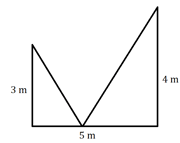Kerala Board Solutions for Chapter: Polynomials, Exercise 2: Exercise 2
Kerala Board Mathematics Solutions for Exercise - Kerala Board Solutions for Chapter: Polynomials, Exercise 2: Exercise 2
Attempt the free practice questions on Chapter 1: Polynomials, Exercise 2: Exercise 2 with hints and solutions to strengthen your understanding. Standard 9 Mathematics Part - 2 solutions are prepared by Experienced Embibe Experts.
Questions from Kerala Board Solutions for Chapter: Polynomials, Exercise 2: Exercise 2 with Hints & Solutions
Write the relation below in algebra and see if it gives a polynomial. Give reasons for your conclusion also.
Two poles of heights and are erected upright on the ground, apart. A rope is to be stretched from the top of one pole to some point on the ground and from there to the top of the other pole:

The relation between the distance of the point on the ground from the foot of a pole and the total length of the rope.
Write the relation below in algebra and find out which are polynomials and explain why.
Sum of a number and its reciprocal.
Write the relation below in algebra and find out which are polynomials and explain why.
Sum of a number and its square root.
Write the relation below in algebra and find out which are polynomials and explain why.
Product of the sum of difference of a number and its square root.
Find polynomial satisfying the set of conditions below.
First degree polynomial with and .
Find polynomial satisfying the set of conditions below.
First degree polynomial with and .
Find polynomial satisfying the set of conditions below.
Second degree polynomial with and .
Find polynomial satisfying the set of conditions below.
Three different second degree polynomials with and .
